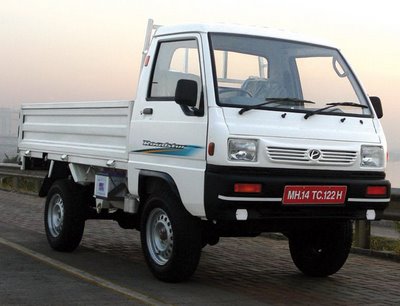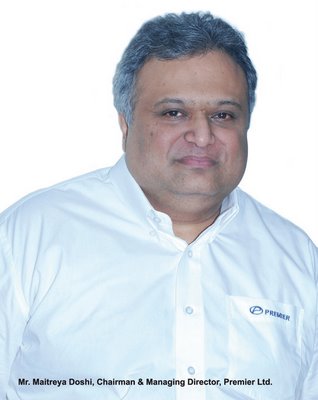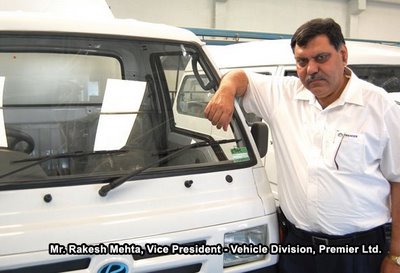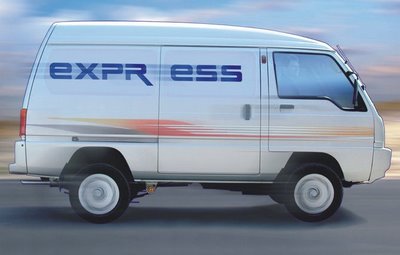
If there is anyone out there who had written off Premier from the history of Indian auto industry, it’s time to revise the decision. Premier is back, the only difference being that the company in its new avatar will focus on the commercial vehicle segment instead of passenger cars.
Winds of change are blowing right across the company, from the shop floor to the top management. There is an air of confidence and determination with the employees at Premier. Driving the change from top is the thrid generation scion of Premier’s founding family, Mr. Maitreya Doshi. The name of the company has been changed from Premier Automobile Ltd. to Premier Ltd. It has also adopted a new logo to emphasize that the company is not only a vehicle manufacturer but, in fact, is also an important machine tool and engineering company. The company has moved to its new corporate headquarters at Chinchwad in Pune.
Established in 1944, Premier was one of the first Indian companies to start making automobiles. In collaboration with Chrysler Corporation, India’s first car rolled out of the Premier factory in 1947, and later in collaboration with Fiat, Premier first started assembling the Fiat 500 in India. In 1954 came the Fiat 1100, one of the most popular models ever produced in the company.
Apart from the most popular car in India, the Premier Padmini, the company also manufactured the India’s widest range of commercial vehicles for a variety of road transport applications. Years from 1996 to 2004 was a particularly difficult phase in the company’s history. However, the indomitable spirit of the management team overcame the adversities and restored the company to profitability and growth.
Mr. Maitreya Doshi says: “When the going gets tough, the tough gets going. These past few years have indeed been difficult for our company, having had to face extreme challenges that threatened our very survival. However, with teamwork, determination and tenacity, I am happy to say we have overcome all our problems. We are now on a path of stability, consolidation and growth”. The company now has 3 main businesses: Machine Tools, Engineering and Vehicles. Premier has a very strong historical presence in the Indian machine tool industry with its own brand of products. In the engineering division the company manufactures complex components for the auto, wind mill and power generating industries. Its clients include blue chip companies viz: Tata Motors, Enercon, Cummins etc. The Vehicle Division is responsible for the new range of light commercial vehicles.
The company now has 3 main businesses: Machine Tools, Engineering and Vehicles. Premier has a very strong historical presence in the Indian machine tool industry with its own brand of products. In the engineering division the company manufactures complex components for the auto, wind mill and power generating industries. Its clients include blue chip companies viz: Tata Motors, Enercon, Cummins etc. The Vehicle Division is responsible for the new range of light commercial vehicles.
“We will focus on three main activities, namely, vehicles, machine tools and engineering services. All three divisions will be continually expanded to create more activity and employment. The company, despite all its difficulties, has already invested over Rs. 175 crores in all the businesses in the past three years alone and plans to add another Rs. 50 crores in the next year. There is no plan to close or reduce any of these activities, and we will, in fact, be sharpening our focus on international exports of all the three products, in addition to our local sales”, adds Mr. Doshi
Vehicle Division
Vehicle manufacturing has always been Premier’s forte. In fact, Premier is remembered as a company which manufactured rugged, fuel-efficient vehicles more suited for Indian roads. In keeping with this philosophy, in 2004, it decided to take a relook at the vehicle business.
From being a manufacturer of products for the mass market, Premier identified certain niche segments in the commercial vehicle segment. The company decided to work with Mitsubishi for developing small commercial vehicles through the latter’s affiliate in Taiwan, CMC.
Thanks to its long history and experience in automobile business, particularly its proven strength in adaptive engineering, Premier has developed two commercially saleable products – the Sigma Van and the Roadstar Pick-up with several variants, all duly homologated and certified by ARAI, Pune.
The Vehicle Division has been more in a project phase so far, and from the current financial year, 2009-10, the company will ramp up volumes more aggressively in the market place. “Our Vehicle Business has developed and fine-tuned its products as per the market needs and, it is now set to move from a project phase to a commercial production phase, rolling out the range of new generation utility vehicles through a network of nearly 50 dealerships”, says Mr. Rakesh Mehta, Vice President – Vehicle Division, Premier Ltd. The company has fully established its vehicle assembly capacity, including the body shop, vehicle assembly line, engine and gear box assembly. It is also setting up a paint shop. Currently, the installed capacity is 15,000 vehicles per annum which can be scaled up to 20,000 units based on the market demand. This entire project has been conceived on the premise of achieving volumes and profitability by exploiting niche markets.
The company has fully established its vehicle assembly capacity, including the body shop, vehicle assembly line, engine and gear box assembly. It is also setting up a paint shop. Currently, the installed capacity is 15,000 vehicles per annum which can be scaled up to 20,000 units based on the market demand. This entire project has been conceived on the premise of achieving volumes and profitability by exploiting niche markets.
Since niche markets, by definition, have smaller volume potential, the business model is based on low capital investment and a high degree of outsourced parts and components. This delivers a low breakeven volume. Premier has invested Rs. 50 crores on the vehicle project.
Roadstar pick-up trucks
Premier has clearly identified a niche in the cargo segment. Typically in the smaller vehicles with payload of less than 2.5 tonnes, it has the three-wheelers with payload of 0.5 tonnes. Then come the Tata Ace and Piaggio Ape Truk with payload of 0.75 tonnes, and then the Mahindra Maxx with a payload of 2 tonnes.
The Ace and the three-wheelers are more for intra-city transportation and the Maxx for inter-city applications. There is a clear gap between the Tata Ace and the Mahindra Maxx in terms of payload, pricing and application, and this is exactly where Premier has positioned its cargo variant, the Roadstar. The Roadstar, which comes with a 1.5 litre diesel engine and a certified payload of 1.4 tonnes has been designed to perfectly meet the requirements of intra-city and inter-city applications. The implementation of highway infrastructure combined with increasing disallowance of large trucks entering city/town limits, the goods transportation model is increasingly becoming “hub and spoke” with a greater need for small feeder vehicles for “last mile” delivery. With many industries demanding “just in time” supplies from their vendors, there is a growing demand for small, fuel-efficient goods vehicles to commute several times a day.
The Roadstar, which comes with a 1.5 litre diesel engine and a certified payload of 1.4 tonnes has been designed to perfectly meet the requirements of intra-city and inter-city applications. The implementation of highway infrastructure combined with increasing disallowance of large trucks entering city/town limits, the goods transportation model is increasingly becoming “hub and spoke” with a greater need for small feeder vehicles for “last mile” delivery. With many industries demanding “just in time” supplies from their vendors, there is a growing demand for small, fuel-efficient goods vehicles to commute several times a day.
The Roadstar, originally a Mitsubishi design, had MacPhearson struts for its front suspension. This is a significant technological improvement over the conventional leaf spring suspension, adding to driver comfort and ease of steering.
However, in the Indian context, the vehicles are being overloaded by nearly 50-100 per cent of their permitted payload and driven on poor roads, resulting in struts breakage, a safety hazard. Consequently, the company had to take a retrograde step and re-engineer the vehicle with a leaf spring front suspension in order to make the product commercially acceptable. This re-engineering process has been completed and the vehicles now come with mechanical leaf springs.
The Roadstar is available in both Euro II and Euro III versions. The company is already working on the Euro IV version to meet emission regulations from April 2010 in all major metros. The vehicle is also available in CNG version. Certified by ARAI, the CNG version will be very useful in New Delhi (NCR), Gujarat and other parts of the country where diesel commercial vehicles are totally banned.
In terms of applications, the company offers the normal cargo box as the basic models and has also developed a tipper version particularly for garbage removal application. It has also developed a fire truck and refrigerated carrier and is working on several other applications in order to widen the marketability of products.
In fact, my personal driving experience of the Roadstar was very impressive. The vehicle has a 1.5 litre 4 cylinder engine which is double the power of the sub one-tonners available in the market. The vehicle has more engine power resulting in better pulling capacity even on higher gradients. It is compact and has a sturdy design, strong and rugged, built for high speed and higher payload. It has a large, flat 8’ long deck, with no loss of space due to protruding wheel arches, which means that there is a lot more area for loading the cargo. Further, the low loading height and a 3-way opening deck aids easy loading and unloading. The company claims that it can touch top speeds of 100 kmph with full load. This will be of great advantage for inter-city applications.
The Roadstar has a very low turning radius which makes it extremely easy to manoeuvre within congested city lanes and has a higher ground clearance for safe travel on rough, uneven roads. Besides, the vehicle comes fitted with disc brakes in the front and drum brakes in the rear to ensure efficient braking.
Sigma
Sigma is a multi-purpose vehicle (MPV) with a variety of applications including passenger transportation, ambulance and even for express cargo delivery. This segment again has entry level products like Maruti Omni, Versa, Tata Magic and Tempo Traveller from Force Motors and Tata Winger in the top end.
The Sigma has been positioned right in between these two segments by offering the flexibility of Omni and Magic in terms of manoeuvrability and offers more pulling power due to a 1.4 litre diesel engine. The rise of new industries such as IT, BPO, Call Centres as well as the increase in tourism is creating a strong need for multi seater passenger vans. Also the national emphasis on healthcare as well as the growth of organized retail will give rise to demand for ambulances and cargo vans. The Sigma passenger van is available in 5, 7, 8 and 9 seater configuration, both AC and without AC options with a five speed transmission. The company has also developed an ambulance (Sigma Lifeline) and a cargo (Sigma Express) variant of this van.
The Sigma passenger van is available in 5, 7, 8 and 9 seater configuration, both AC and without AC options with a five speed transmission. The company has also developed an ambulance (Sigma Lifeline) and a cargo (Sigma Express) variant of this van.
I’ve personally driven the Maruti Omni for many years and I can say that, Sigma has all that Omni missed out – AC, a very powerful engine for better pulling power, sturdy and offers better road grip and most importantly it comes with a diesel engines which makes it more economical compared to the petrol options available in the market.
“Premier is also targeting certain niche applications like Ambulance and Express Cargo service. In a vehicle for a medical emergency unit, patient comfort is critical. So is speed and ease of manoeuvrability. Sigma Lifeline meets both the requirements and provides the right combination of features”, adds Mr. Mehta.
These ambulances are factory built and come with stretcher, first aid box, oxygen cylinder holder, emergency siren, beacon and a storage cupboard for the necessary emergency medical requirements. Sigma Lifeline is best suited for hospitals, nursing home, social institutes, industrial units, trusts, private doctors, government health departments.
Dealer network
Premier has completely revamped its dealer network. The company has 50 operative dealers located in Gujarat, Maharashtra, Goa, Andhra Pradesh, Kerala, Tamil Nadu and Karnataka. The current focus is to establish the products in West and South India before expanding to the North and East. The dealership target is to reach 100 by March ‘10, creating an all-India network, adds Mr. Mehta.
Service is an important area to focus. Premier has set up a zonal management structure that overseas parts, service and dealer training regularly. The company has established 6 regional helplines for customer care and service. “If there is a vehicle breakdown, our service team will reach within a maximum period of two hours to any location. We know how important it is for our customers to keep the vehicle up and running”, adds Mr. Mehta.
Premier is clearly making a comeback. The process of re-establishing the company and products is slow but steady. Given the tough competition and the number of brands available in the market, it will take some time for Premier to re-establish its brand in the market.
What is really working to Premier’s advantage is its loyal workforce which has stayed with the company even during the tough times. Now with the products in place, Premier is all set to regain its past pre-eminence.